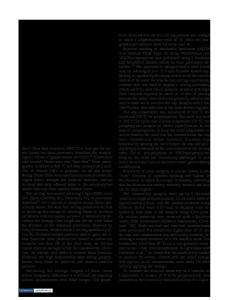Improving the Electrical Conductivity of Composites Comprised of Short Conducting Fibers in a Nonconducting Matrix: The
- PDF / 405,670 Bytes
- 6 Pages / 414.72 x 648 pts Page_size
- 92 Downloads / 354 Views
PU-WOEI CHEN AND D.D.L. CHUNG Composite Materials Research Laboratory, Furnas Hall, State University of New York at Buffalo, Buffalo, New York 14260-4400
ABSTRACT The addition of a second discontinuous filler (silica fume) that is essentially nonconducting to a composite with a comparably non-conducting matrix (cement) and a conducting discontinuous filler (carbon fibers) was found to increase the electrical conductivity of the composite when the conducting filler volume fraction was less than 3.2%. Themaximum conducting filler volume fraction for the second filler to be effective was only 0.5% when the second filler was sand, which was much coarser than silica fume. The improved conductivity due to the presence of the second filler is due to the improved dispersion of the conducting filler. The silica fume addition did not affect the percolation threshold, but the sand addition increased the threshold.
INTRODUCTION Non-conducting or essentially non-conducting materials (such as polymers and ceramics) can be rendered electrically conducting by the addition of an electrically conducting filler, which is usually discontinuous for the sake of convenience in composite fabrication by injection molding, slurry casting or other techniques. These composites are widely used in electronic packaging as die attach adhesives, solder replacement, interconnections and electromagnetic interference shields. The development of these composites has been centered around the choice of the conducting filler or fillers, with particular attention given to the composition(s), size(s), shape(s) and volume fraction(s) of the filler(s) [1-3]. Much less attention has been given to the choice of the non-conducting matrix orthe non-conducting filler that may coexist with the conducting filler. In the case of composite fabrication using a mixture of the matrix powder and the discontinuous conducting filler(s), attention has been given to the size of the matrix particles relative to that of the conducting filler, as a smaller relative size of the filler decreases the critical filler volume fraction needed for conduction via percolation [4,5]; in the subcase that the polymer is a thermoplast, attention has also been given to the effect of the viscosity of the polymer during composite fabrication on the electrical conductivity of the resulting composite [6]. In contrast, in this paper, attention is given to the effect of an essentially non-conducting coexisting filler on the electrical conductivity of the composite. Both the matrix and the additional filler (of unit size much smaller than that of the conducting 141
Mat. Res. Soc. Symp. Proc. Vol. 390 ©1995 Materials Research Society
filler) wereessentially non-conducting, but the presence of the additional filler was found in this work to significantly increase the electrical conductivity of the composite. This effect is attributed to the improvement in the conducting filler dispersion due to the presence of the additional filler. Low conducting filler volume fractions are often used in practic
Data Loading...











